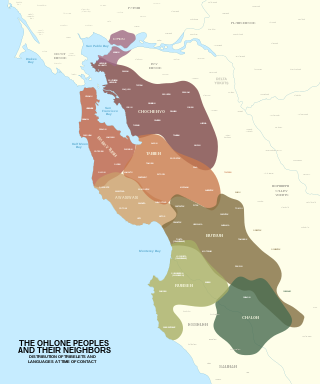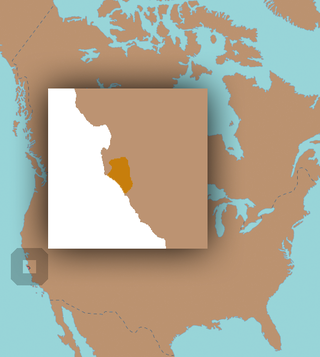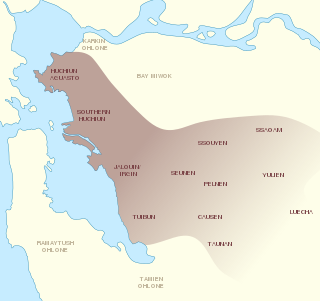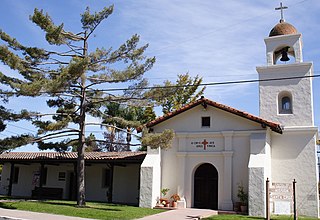
The Ohlone, formerly known as Costanoans, are a Native American people of the Northern California coast. When Spanish explorers and missionaries arrived in the late 18th century, the Ohlone inhabited the area along the coast from San Francisco Bay through Monterey Bay to the lower Salinas Valley. At that time they spoke a variety of related languages. The Ohlone languages make up a sub-family of the Utian language family. Older proposals place Utian within the Penutian language phylum, while newer proposals group it as Yok-Utian.

The Esselen are a Native American people belonging to a linguistic group in the hypothetical Hokan language family, who are indigenous to the Santa Lucia Mountains of a region south of the Big Sur River in California. Prior to Spanish colonization, they lived seasonally on the coast and inland, surviving off the plentiful seafood during the summer and acorns and wildlife during the rest of the year.

Esselen was the language of the Esselen Nation, which aboriginally occupied the mountainous Central Coast of California, immediately south of Monterey. It was probably a language isolate, though has been included as a part of the hypothetical Hokan proposal.
The Lamchin were one of many tribes of the Ohlone (Coastanoan) people, Native Americans who lived along the San Francisco Peninsula. The Lamchin were the native inhabitants of what is now San Carlos, California. Information is sparse and dispersed, coming mostly from Spanish mission records – as the natives had no written language. The collected information follows over 100 years of research by many noted historians. The Lamchin are believed to be extinct – as historical, statistical and limited written accounts would seem to indicate.
The Karkin language is an extinct Ohlone language. It was formerly spoken in north central California, but by the 1950s there were no more native speakers. The language was historically spoken by the Karkin people, who lived in the Carquinez Strait region in the northeast portion of the San Francisco Bay estuary.

The Chalon people are one of eight divisions of the Ohlone (Costanoan) people of Native Americans who lived in Northern California. Chalon is also the name of their spoken language, listed as one of the Ohlone languages of the Utian family. Recent work suggests that Chalon may be transitional between the northern and southern groups of Ohlone languages.

Mutsun is a Utian language spoken in Northern California. It was the primary language of a division of the Ohlone people living in the Mission San Juan Bautista area. The Tamien Nation and Amah Mutsun band is currently working to restore the use of the language, using a modern alphabet.
The mythology of the Ohlone (Costanoan) Native American people of Northern California include creation myths as well as other ancient narratives that contain elements of their spiritual and philosophical belief systems, and their conception of the world order. Their myths describe supernatural anthropomorphic beings with the names of regional birds and animals, notably the eagle, the Coyote who is humanity's ancestor and a trickster spirit, and a hummingbird.

The Awaswas, also known as the Santa Cruz people, were a group of the Indigenous peoples of California in North America, with subgroups historically numbering about 600 to 1,400. Academic research suggests that their ancestors had lived within the Santa Cruz Mountains region for approximately 12,000 years. The Awaswas maintained regular trade networks with regional cultures before the Spanish colonists began settling in the area from the 18th century.

The Tamien people are one of eight linguistic divisions of the Ohlone (Costanoan) people groups of Native Americans who live in Northern California. The Tamien traditionally lived throughout the Santa Clara Valley. The use of the name Tamien is on record as early as 1777, it comes from the Ohlone name for the location of the first Mission Santa Clara on the Guadalupe River. Father Pena mentioned in a letter to Junipero Serra that the area around the mission was called Thamien by the native people. The missionary fathers erected the mission on January 17, 1777, at the native village of So-co-is-u-ka.

The Chochenyo are one of the divisions of the Indigenous Ohlone (Costanoan) people of Northern California. The Chochenyo reside on the east side of the San Francisco Bay, primarily in what is now Alameda County, and also Contra Costa County, from the Berkeley Hills inland to the western Diablo Range.
Tukutnut is a former Rumsen settlement in Monterey County, California.

The Ohlone languages, also known as Costanoan, form a small Indigenous language family historically spoken in Northern California, both in the southern San Francisco Bay Area and northern Monterey Bay area, by the Ohlone people. Along with the Miwok languages, they are members of the Utian language family. The most recent work suggests that Ohlone, Miwok, and Yokuts are branches of a Yok-Utian language family.

Isabel Meadows was an Ohlone ethnologist and the last fluent speaker of the Rumsen Ohlone language. She also spoke Esselen. She worked closely with the anthropologists from the Smithsonian Institution for more than five years in order to document her culture and language. Her work is considered fundamental in the study of Ohlone languages.
The Chalon language is one of eight Ohlone languages, historically spoken by the Chalon people of Native Americans who lived in Northern California. Also called Soledad, it belongs to the one of the Ohlone languages of the Utian family. Recent work suggests that Chalon may be transitional between the northern and southern groups of Ohlone languages.
The Tamyen language is one of eight Ohlone languages, once spoken by Tamyen people in Northern California.

The Rumsen are one of eight groups of the Ohlone, an indigenous people of California. Their historical territory included coastal and inland areas within what is now Monterey County, California, including the Monterey Peninsula.
The Karkin people are one of eight Ohlone peoples, indigenous peoples of California.

Awaswas, or Santa Cruz, is one of eight Ohlone languages. It was historically spoken by the Awaswas people, an indigenous people of California.













